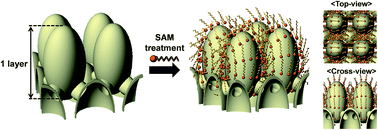Controlled three-dimensional interconnected capillary structures for liquid repellency engineering†
Abstract
In this study, we investigated the wetting properties of solvents on highly periodic, porous substrates which have five different layer thicknesses (1, 3, 5, 9 and 13 layers) of three-dimensional (3D) nanoshell structured TiO2 with interconnected capillary spaces. After phosphonic acid (HDF-PA) self-assembly, contact angles of 3D nanoshell structured TiO2 enhanced with increasing number of layers but saturated from 9 layers and up. The omniphobic properties with different types of liquids—deionized water, dextrose, saline, and amino acid injection—were demonstrated by using the 3D-nanoshell-structured TiO2 with 9 layers.


 Please wait while we load your content...
Please wait while we load your content...